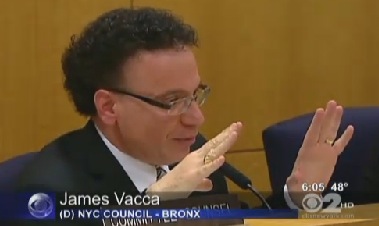
James Vacca should know better.
On Tuesday, the City Council passed his bill requiring the Department of Transportation to consult with the Department of Small Business Services, among other agencies, whenever it implements major changes to a street. Vacca gave this explanation of the bill's significance: "Many of the bike paths, many of the pedestrian plazas negatively impact small businesses and their ability to survive in the City of New York."
Say what?
Just about every single plaza that DOT has built or approved (see here, here, here, and here) is sponsored by a local business association. The tiny handful that are not still have prominent local sponsors like Heritage Health and Housing in West Harlem. We reached out to Vacca's office to ask him to specify some of the "many" plazas that have hurt small business. So far, there's been no reply.
As chair of the City Council Transportation Committee, Vacca has a talented staff to make sure he understands the issues. So why does he keep mangling them in public?
Vacca can't plead ignorance. At a hearing on public plazas in his own committee earlier this year, Vacca heard from representatives of four business groups: the 34th Street Partnership, the Dumbo BID, the Pitkin Avenue BID, and the South Bronx Overall Economic Development Corporation. Each of them raved about the plazas.
Mario Bodden, the assistant vice president of community development at SoBro, had this to say about DOT's Roberto Clemente Plaza to his fellow Bronxite: "I am so proud of it. I am very passionate about it. I want the City Council to put more money in the plaza program." If business representatives like Bodden didn't feel that way, they wouldn't keep lining up to sponsor more plazas.
The available data bolster what these business leaders know in their gut: A better pedestrian environment is good for the bottom line. Retail rents in Times Square continued to rise after DOT turned traffic lanes into public plazas on Broadway in 2009. This year Times Square cracked Cushman & Wakefield's list of the world's top ten retail districts for the first time.
As for the effect of NYC bike lanes, hard data is scarce, but walk down any of the commercial avenues with protected lanes, and the retail environment looks healthy. Yes, Columbus Avenue business owners complained about the new bike lane's effect on parking and deliveries, but merchants are notoriously bad judges of the issue, and a 2007 survey found that only two percent of the people on Columbus Avenue got there by driving [PDF]. Studies from other cities, meanwhile, show solid evidence that bike lanes can improve business.





